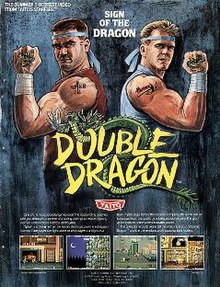
Back دابل دراغون Arabic دوبل دراجون ARZ Double Dragon Catalan Double Dragon (Computerspiel) German Double Dragon Spanish Double Dragon Basque Double Dragon (videopeli) Finnish Double Dragon (jeu vidéo, 1987) French Double Dragon Italian ダブルドラゴン (1987年のゲーム) Japanese
This article needs additional citations for verification. (September 2015) |
| Double Dragon | |
|---|---|
 American arcade flyer. The characters have their names localized as Hammer and Spike. | |
| Developer(s) |
|
| Publisher(s) | |
| Director(s) | Yoshihisa Kishimoto Shinichi Saito |
| Producer(s) | Yoshihisa Kishimoto |
| Designer(s) | Koji Kai Shinichi Saito |
| Programmer(s) | Hiroshi Satoh Tomoyasu Koga Nari Nishimura Hideki Kaneda |
| Artist(s) | Kumiko Mukai Mizuho Yama Akemi Tasaki Misae Nakaya Masato Shiroto |
| Composer(s) | Kazunaka Yamane |
| Series | Double Dragon |
| Platform(s) |
|
| Release | Arcade Famicom/NES Master System |
| Genre(s) | Beat 'em up |
| Mode(s) | Up to 2 players, simultaneous |
| Arcade system | Custom |
Double Dragon[a][b] is a 1987 beat 'em up video game developed by Technōs Japan and distributed by Taito for arcades across Asia, North America and Europe. It is the first title in the Double Dragon franchise. The game's development was led by Yoshihisa Kishimoto, and it is a spiritual and technological successor to Technos' earlier beat 'em up, Nekketsu Kōha Kunio-kun (1986), released outside of Japan by Taito as Renegade; Kishimoto originally envisioned it as a direct sequel and part of the Kunio-kun series, before making it a new game with a different cast and setting.
Double Dragon introduced several additions to the Kunio-kun belt scroll beat 'em up formula, such as a continuous side-scrolling world adding a sense of progression, two-player cooperative gameplay, the ability to arm oneself with an enemy's weapon after disarming them, and the use of cut scenes to give it a cinematic look and feel. The game's title is a reference to the two-player gameplay and Bruce Lee's martial arts film Enter the Dragon (1973), which was a major inspiration behind Kunio-kun and Double Dragon, while the game's art style and setting were influenced by the Mad Max films and Fist of the North Star manga and anime series.
Double Dragon was one of the first successful beat 'em up games, becoming Japan's third highest-grossing table arcade game of 1987 before becoming America's highest-grossing dedicated arcade game for two years in a row, in 1988 and 1989. It also received critical acclaim, with Electronic Gaming Monthly awarding it 1988 Game of the Year. Its success resulted in the creation of the Double Dragon franchise, including two arcade sequels and several spinoffs, and it ushered in a "Golden Age" for the beat 'em up genre, establishing the conventions for a wave of beat 'em ups from other companies during the late 1980s to 1990s. Originally an arcade game, home versions were released for the NES, Master System, Atari 2600, Atari 7800, Atari ST, Amiga, Amstrad CPC, Commodore 64, Game Boy, Genesis/Mega Drive, and Atari Lynx, among other platforms during the series's height of popularity. A remake titled Double Dragon Advance was released for the Game Boy Advance in 2003.
- ^ Cite error: The named reference
CGWwas invoked but never defined (see the help page). - ^ "Double Dragon (Registration Number PA0000327710)". United States Copyright Office. Retrieved 24 May 2021.
- ^ Cite error: The named reference
CVG_ARCwas invoked but never defined (see the help page). - ^ "Double Dragon (Video Game 1987) - Release Info". IMDb.
- ^ a b "Double Dragon Release Information for NES". GameFAQs.
- ^ "Availability Update" (PDF). Computer Entertainer. December 1988. p. 13.
- ^ "Sega Mark III". セガハード大百科 (in Japanese). Sega. Retrieved 15 August 2021.
- ^ Retro Gamer, issue 1, p. 58, 2004
- ^ "Double Dragon". Flyer Fever.
Cite error: There are <ref group=lower-alpha> tags or {{efn}} templates on this page, but the references will not show without a {{reflist|group=lower-alpha}} template or {{notelist}} template (see the help page).
© MMXXIII Rich X Search. We shall prevail. All rights reserved. Rich X Search